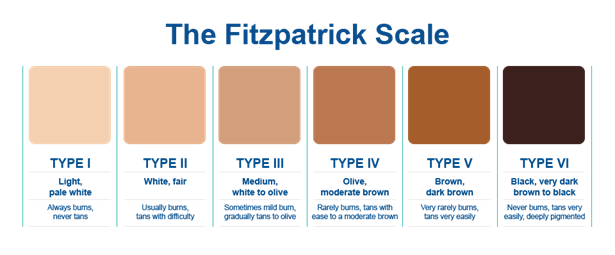Written by Margaret Kontras Sutton, M.D.
In 1975, Thomas Fitzpatrick, a Harvard dermatologist developed a grading system for skin based on how the skin responded to ultraviolet light. Using his system, skin is classified as Types I through VI:
Type I Always burns, never tans. These individuals have pale white skin, blond or red hair, blue eyes, and freckles.
Type II Usually burns, tans poorly. These individuals have white skin, blond or red hair, and blue or green eyes.
Type III Tans after initial burn, then tans well. Creamy skin tone and blue, green or brown eyes.
Type IV Tans well. Light brown skin tone, usually brown eyes.
Type V Rarely burns. Has dark brown skin tone and brown eyes.
Type VI Never burns. Is deeply pigmented with the darkest skin tone.
Now that you know how to determine the Fitzpatrick Skin Type, what skin type are you? You may have noticed that your skin type is hereditary and based on your ethnic background.
Being of Greek descent (all four of my grandparents were 100% Greek) I have skin which tans well (if I would ever allow that) and hazel eyes. I would classify my skin as Type III.
So why is this skin typing important? For one thing it can assist in predicting the likelihood of developing skin cancer. Individuals with skin Types I and II are far more likely to develop skin cancers of all kinds. This of course makes sense since their skin does not have as much pigmentation which is “nature’s sunscreen”. Not only do these individuals have increased risk of skin cancer, but they may develop skin cancer at a younger age. I would have to say that I always take skin type into consideration when evaluating a patient for skin cancer.
Besides predicting risk of developing skin cancer there are other predictions that we can make by knowing skin type. Stay tuned for next week’s topic “The Botched Blotch”.





Leave a Reply